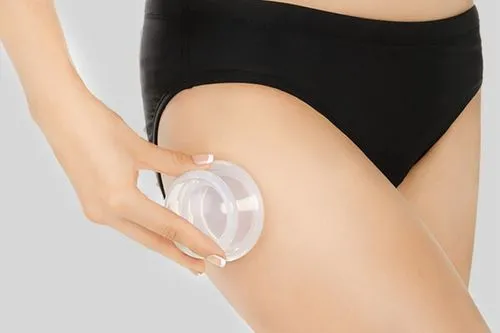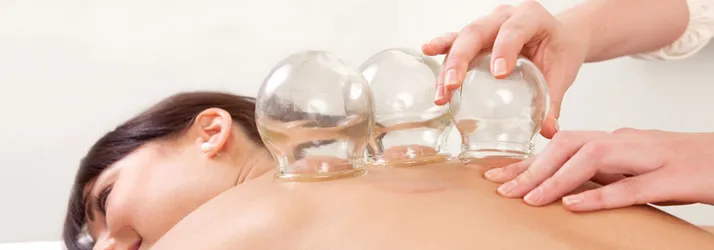
If you're tired of battling stubborn cellulite, it's time to explore the ancient practice of cupping therapy. This holistic approach to wellness has gained popularity in recent years for its ability to address a wide range of health concerns, including cellulite reduction. In this blog, we'll delve into the world of cupping therapy and how it can help you achieve smoother, firmer skin. From understanding the fundamentals of cupping therapy to exploring its effectiveness for cellulite reduction, we'll cover everything you need to know to make an informed decision about incorporating this technique into your wellness routine. Whether you're curious about combining cupping therapy with other treatments or considering DIY options for at-home use, we'll provide valuable insights to help you navigate your journey to cellulite reduction. So, if you're ready to bid farewell to dimpled skin and embrace a more confident, revitalized you, let's dive into the world of cupping therapy and discover the transformative potential it holds for reducing cellulite.
Cupping therapy is an ancient alternative medicine practice that involves placing cups on the skin to create suction. This suction can help improve blood flow, loosen muscles, and reduce inflammation. There are different types of cupping therapy, including dry cupping, wet cupping, and fire cupping.
The benefits of cupping therapy include reducing pain, promoting relaxation, improving skin health, and aiding in overall well-being. The suction created by the cups can also help with detoxification by drawing out toxins from the body's tissues. Many people have found relief from various ailments through regular cupping therapy sessions.
Different techniques and variations in the application of cups allow for targeted treatment for specific issues such as cellulite reduction. By understanding how cupping therapy works and its potential benefits, individuals can make informed decisions about incorporating this practice into their wellness routines.
Research has shown that cupping therapy can be effective in reducing the appearance of cellulite. A study published in the Journal of Acupuncture and Meridian Studies found that participants who received cupping therapy showed a significant reduction in the severity of their cellulite after just five weeks of treatment. This suggests that cupping therapy may be a viable option for those looking to address their cellulite concerns.
In addition to research findings, many individuals have reported success with using cupping therapy to target and reduce cellulite. Personal stories often highlight how consistent and regular sessions of cupping therapy have led to noticeable improvements in skin texture and firmness, particularly in areas prone to cellulite accumulation such as thighs and buttocks.
Expert opinions also support the use of cupping therapy as a potential treatment for cellulite. Professionals in the field believe that the technique used in cupping can help improve blood circulation, break down fat deposits under the skin, and stimulate lymphatic drainage – all factors known to contribute to the development of cellulite.
When it comes to reducing cellulite, combining cupping therapy with other treatments can be more effective than using cupping therapy alone. For instance, incorporating massage therapy alongside cupping can help break up the fat deposits that cause cellulite and improve blood circulation in the affected areas. This combined approach may result in a more noticeable reduction in the appearance of cellulite.
In addition to massage therapy, paying attention to diet while undergoing cupping treatment for cellulite is vital. Eating a balanced and healthy diet rich in fruits, vegetables, lean protein, and whole grains can complement the effects of cupping therapy by aiding in overall body detoxification and improving skin health. Combining the benefits of an improved diet with regular cupping sessions may lead to better results for individuals looking to reduce their cellulite.
Lastly, incorporating exercise into your routine while undergoing cupping therapy can further enhance the effects of both treatments. Engaging in physical activity such as strength training or cardio exercises can help tone muscles, improve circulation, and promote overall wellness – all of which contribute to minimizing the appearance of cellulite when coupled with regular cupping sessions.

When seeking a cupping therapist for cellulite treatment, it is important to consider their qualifications. Look for a therapist who has completed proper training and certification in cupping therapy. This can include courses in traditional Chinese medicine or other related fields. Additionally, inquire about their experience with treating cellulite specifically using cupping therapy.
Finding a reputable cupping clinic is another crucial aspect of choosing the right therapist. Research potential clinics online and read reviews from previous clients to gauge their reputation and success rates. It is also helpful to ask for recommendations from friends or family who have undergone similar treatments for cellulite reduction.
Before committing to a cupping therapist, be sure to ask questions that will help you feel comfortable and confident in your abilities. Inquire about the techniques they use, expected outcomes, and any potential risks or side effects of the treatment. A competent therapist should be able to address these concerns thoroughly before beginning the sessions.
Common side effects of cupping therapy may include temporary bruising, skin irritation, and discomfort at the site where the cups were applied. These side effects usually resolve within a few days.
It is important to take precautions when undergoing cupping therapy. Individuals with certain medical conditions such as hemophilia or those who are pregnant should avoid this type of treatment. Additionally, it's crucial to seek out a qualified and experienced practitioner to minimize any potential risks.
If you have an open wound or sunburn, it's best to avoid cupping therapy in that area. It's also advisable not to undergo cupping on areas with large blood vessels, varicose veins, or any skin lesions.
When seeking cellulite reduction through cupping therapy, it is important to have realistic expectations. While cupping therapy can help improve the appearance of cellulite, it may not eliminate it. It is essential to understand that individual results may vary and that full cellulite reduction may not be achievable for everyone.
The timeframe for seeing results from cellulite cupping therapy can also vary. Some individuals may notice improvements after just a few sessions, while others may take longer to see noticeable changes. **Patience and consistency are key **when managing expectations for cellulite reduction with cupping therapy.
Even after achieving the desired results, maintaining cellulite reduction requires ongoing care and maintenance. Continuing with regular cupping treatments and adopting a healthy lifestyle will contribute to the long-term management of cellulite. It is crucial to set realistic goals and maintain a positive mindset throughout the process.
The cost of cupping therapy can vary based on several factors, such as the location of the clinic, the experience and reputation of the therapist, and the specific type of cupping treatment being performed. In general, larger cities tend to have higher prices for cupping therapy compared to smaller towns or rural areas. Additionally, therapists with a strong track record and positive reviews may charge more for their services.
When considering the cost of cupping therapy, it's important to compare prices among different clinics in your area. Some clinics might offer package deals or discounts for multiple sessions, so it's worth shopping around before committing to a specific therapist. Keep in mind that while price is an important factor, quality and safety should also be top priorities when choosing a clinic for cupping therapy.
Unfortunately, most insurance plans do not cover cupping therapy as it is considered an alternative or complementary treatment rather than a standard medical procedure. However, some flexible spending accounts (FSAs) or health savings accounts (HSAs) may allow you to use pre-tax dollars towards cupping therapy expenses. Be sure to check with your insurance provider or benefits administrator to see if there are any options available for financial assistance with cupping treatments.
To perform DIY cupping therapy for cellulite, you can use silicone cups that are readily available online or at beauty supply stores. First, apply oil to the area you want to treat, then squeeze the cup and place it on your skin. Release it to create a suction effect, and gently move the cup in circular or zigzag motions over the affected area. It's important to start with light pressure and gradually increase as needed, but be careful not to overdo it.
When performing self-administered cupping treatment for cellulite at home, always prioritize safety. Avoid using cups on damaged or broken skin and never leave them stationary in one spot for too long to prevent bruising or discomfort. Additionally, be mindful of how your body responds during the process. If you experience any unusual pain or irritation, stop immediately and consult a healthcare professional.
Many individuals have found success with at-home cupping techniques when incorporating them into their cellulite-reduction routine. While results may vary from person to person, consistent practice combined with a healthy diet and exercise regimen can potentially lead to improvements in overall skin texture and firmness.
Cupping therapy has shown promising results in reducing the appearance of cellulite. The use of suction and pressure from cupping encourages blood flow and lymphatic drainage, which can help break down fat cells that contribute to cellulite. Additionally, the improvement in circulation can lead to smoother skin texture and reduced dimpling caused by cellulite.
It is important to note that while cupping therapy can be beneficial for reducing cellulite, it may not eliminate it. Consistent and regular sessions may be needed to see significant improvements. It is also recommended to combine cupping therapy with a healthy diet and exercise regimen for optimal results in managing cellulite.
For those interested in exploring cupping therapy further as a treatment option for cellulite reduction, consulting with a certified therapist or healthcare professional is advised. They can provide personalized recommendations based on individual needs and assess whether cupping therapy is suitable as part of an overall approach to managing cellulite.
At Prime Chiro, we understand the importance of finding the best chiropractor near you in Lansvale NSW and surrounding areas. Our team is dedicated to providing top-notch chiropractic care and consultation services to individuals in need. Whether you're dealing with back pain, neck pain, or any other musculoskeletal issues, our experienced chiropractors are here to help. We offer personalized treatment plans to address your specific needs and get you back to feeling your best. Contact Prime Chiro today to schedule a consultation and take the first step towards a healthier, pain-free life.
Cupping therapy is an alternative therapy that involves placing cups on the skin to create suction. This section helps to increase blood flow, reduce inflammation, and promote relaxation.
Cupping therapy can help reduce cellulite by improving blood circulation and lymphatic drainage. The suction created by the cups helps to break up the fatty deposits that contribute to cellulite, allowing the body to eliminate them more effectively.
Cupping therapy is generally not painful, although some people may experience mild discomfort or a sensation of tightness during the treatment. The cups are usually left in place for a few minutes and then removed, leaving temporary marks on the skin that may resemble bruises.
The number of cupping therapy sessions needed to see results can vary depending on individual factors such as the severity of cellulite and overall health. However, most people start to notice improvements after a few sessions, and a series of regular treatments is typically recommended for optimal results.
While cupping therapy is generally safe, some people may experience temporary side effects such as skin discolouration, mild soreness, or dizziness. These side effects are usually mild and resolve on their own within a few days.
Cupping therapy is a popular treatment for reducing cellulite, offering various benefits and potential for success. When considering this therapy, it's important to understand how it works, its effectiveness, and the potential side effects. Additionally, combining cupping therapy with other treatments, choosing the right therapist, and managing expectations are crucial factors to consider. DIY options are available, but it's essential to prioritize safety and effectiveness. Overall, cupping therapy can be a valuable tool in the journey to reduce cellulite.